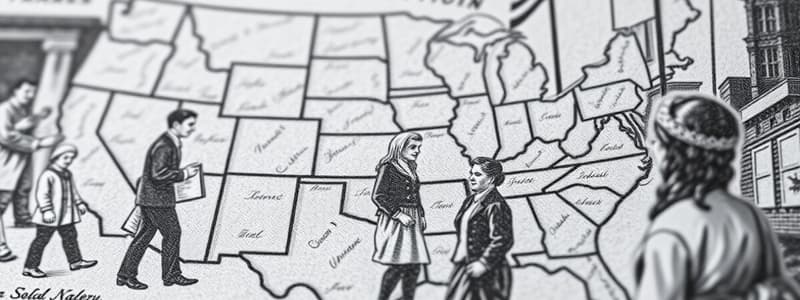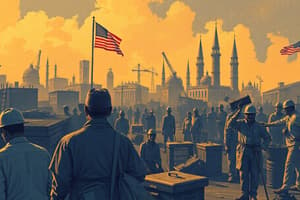Podcast
Questions and Answers
What requirement is imposed by Arizona SB 1070 regarding documented immigrants?
What requirement is imposed by Arizona SB 1070 regarding documented immigrants?
- They must provide proof of employment.
- They are required to attend citizenship classes.
- They must register their vehicles.
- They need to carry identification documents. (correct)
What was one of the main criticisms of DACA?
What was one of the main criticisms of DACA?
- It provides unconditional residency to all immigrants.
- It offers permanent residency to immigrants.
- It could be easily rescinded since it was created by executive action. (correct)
- It requires applicants to have a valid driver's license.
Which statement reflects the sociological perspective on immigration and crime?
Which statement reflects the sociological perspective on immigration and crime?
- There is a negative correlation between immigration and crime. (correct)
- Immigrants are always more likely to commit crimes.
- Cities with fewer immigrants have higher crime rates.
- Increased immigration leads to higher crime rates.
What was one of the consequences of reform regarding the immigrant population in the 1990s?
What was one of the consequences of reform regarding the immigrant population in the 1990s?
What did the Supreme Court rule regarding the Arizona SB 1070?
What did the Supreme Court rule regarding the Arizona SB 1070?
What is one reason noted for the decrease in violent crime in cities with high immigration rates?
What is one reason noted for the decrease in violent crime in cities with high immigration rates?
What must an individual have completed to qualify for DACA?
What must an individual have completed to qualify for DACA?
Which demographic trend was observed among immigrants within the U.S.?
Which demographic trend was observed among immigrants within the U.S.?
What aspect of the DACA program raises concerns among advocates?
What aspect of the DACA program raises concerns among advocates?
What is a reason cited for the perception that immigrants worsen crime rates?
What is a reason cited for the perception that immigrants worsen crime rates?
What was the primary legal argument made by Asian Americans against the Geary Act?
What was the primary legal argument made by Asian Americans against the Geary Act?
What significant change did the Magnuson Act of 1943 introduce?
What significant change did the Magnuson Act of 1943 introduce?
How did the Johnson-Reed Act of 1924 alter immigration quotas?
How did the Johnson-Reed Act of 1924 alter immigration quotas?
What was one of the main purposes of the Bracero Program initiated in 1942?
What was one of the main purposes of the Bracero Program initiated in 1942?
What tactics characterized Operation Wetback, which occurred in the 1950s?
What tactics characterized Operation Wetback, which occurred in the 1950s?
What were the main categories favored by the Immigration and Nationality Act of 1965 for visa allocation?
What were the main categories favored by the Immigration and Nationality Act of 1965 for visa allocation?
What was a notable consequence of the Immigration Reform and Control Act of 1986?
What was a notable consequence of the Immigration Reform and Control Act of 1986?
What did the Illegal Immigration Reform and Immigrant Responsibility Act of 1996 implement?
What did the Illegal Immigration Reform and Immigrant Responsibility Act of 1996 implement?
Which statement best describes the impact of the Immigration and Nationality Act of 1965 on Asian Americans?
Which statement best describes the impact of the Immigration and Nationality Act of 1965 on Asian Americans?
What was the primary limitation imposed by the Naturalization Law of 1790 regarding citizenship?
What was the primary limitation imposed by the Naturalization Law of 1790 regarding citizenship?
Who were explicitly excluded from the naturalization process after the Naturalization Law of 1790?
Who were explicitly excluded from the naturalization process after the Naturalization Law of 1790?
What was a significant outcome of the Chinese Exclusion Act of 1882?
What was a significant outcome of the Chinese Exclusion Act of 1882?
What did the Geary Act of 1892 specifically enforce?
What did the Geary Act of 1892 specifically enforce?
What was the phrase used to describe those excluded from U.S. citizenship after the Naturalization Law of 1790?
What was the phrase used to describe those excluded from U.S. citizenship after the Naturalization Law of 1790?
The Naturalization Law of 1790 primarily targeted which demographic group for citizenship?
The Naturalization Law of 1790 primarily targeted which demographic group for citizenship?
What was the broader implication of the Chinese Exclusion Act for U.S. immigration policy?
What was the broader implication of the Chinese Exclusion Act for U.S. immigration policy?
In what way did the Naturalization Law of 1790 affect white male property owners?
In what way did the Naturalization Law of 1790 affect white male property owners?
How did the requirement for a Certificate of Residence affect Chinese immigrants after the Geary Act?
How did the requirement for a Certificate of Residence affect Chinese immigrants after the Geary Act?
What significant distinction was made in U.S. immigration policy with the enactment of the Chinese Exclusion Act?
What significant distinction was made in U.S. immigration policy with the enactment of the Chinese Exclusion Act?
Flashcards
Arizona SB 1070
Arizona SB 1070
A controversial law requiring documented immigrants to carry identification and allowing police to arrest individuals suspected of being undocumented.
DACA (Deferred Action for Childhood Arrivals)
DACA (Deferred Action for Childhood Arrivals)
A program offering protection from deportation for undocumented immigrants who entered the U.S. as children, meeting specific criteria.
Dream Act
Dream Act
A proposed law aiming to grant a path to citizenship for undocumented immigrants who came to the U.S. as minors.
Assimilation
Assimilation
Signup and view all the flashcards
Immigration and Crime Correlation
Immigration and Crime Correlation
Signup and view all the flashcards
Sociological Explanations for Immigration-Crime Correlation
Sociological Explanations for Immigration-Crime Correlation
Signup and view all the flashcards
How Does Immigration Affect Crime Rates?
How Does Immigration Affect Crime Rates?
Signup and view all the flashcards
Consequences of Immigration Reform
Consequences of Immigration Reform
Signup and view all the flashcards
Increased Penalties for Undocumented Immigrants
Increased Penalties for Undocumented Immigrants
Signup and view all the flashcards
The Impact of Increased Penalties?
The Impact of Increased Penalties?
Signup and view all the flashcards
Naturalization Law of 1790
Naturalization Law of 1790
Signup and view all the flashcards
Who could become a citizen?
Who could become a citizen?
Signup and view all the flashcards
Excluded from Naturalization
Excluded from Naturalization
Signup and view all the flashcards
Chinese Exclusion Act of 1882
Chinese Exclusion Act of 1882
Signup and view all the flashcards
Geary Act (1892)
Geary Act (1892)
Signup and view all the flashcards
Deportation
Deportation
Signup and view all the flashcards
Impact of Chinese Exclusion Act
Impact of Chinese Exclusion Act
Signup and view all the flashcards
Fong Yue Ting v. United States
Fong Yue Ting v. United States
Signup and view all the flashcards
Aliens Ineligible for Citizenship
Aliens Ineligible for Citizenship
Signup and view all the flashcards
Geary Act Challenge (1893)
Geary Act Challenge (1893)
Signup and view all the flashcards
Chinese Exclusion Act Repeal (1943)
Chinese Exclusion Act Repeal (1943)
Signup and view all the flashcards
Emergency Quota Act (1921)
Emergency Quota Act (1921)
Signup and view all the flashcards
Johnson-Reed Act (1924)
Johnson-Reed Act (1924)
Signup and view all the flashcards
Bracero Program (1942-1964)
Bracero Program (1942-1964)
Signup and view all the flashcards
Operation Wetback (1950s)
Operation Wetback (1950s)
Signup and view all the flashcards
Immigration and Nationality Act (1965)
Immigration and Nationality Act (1965)
Signup and view all the flashcards
Immigration Reform and Control Act (1986)
Immigration Reform and Control Act (1986)
Signup and view all the flashcards
Illegal Immigration Reform and Immigrant Responsibility Act (1996)
Illegal Immigration Reform and Immigrant Responsibility Act (1996)
Signup and view all the flashcards
Study Notes
Immigration History
- Naturalization Law of 1790: Restricted naturalization, primarily to free white persons of good moral character after two years' residency.
- Chinese Exclusion Act of 1882: The first major US immigration law, targeting Chinese immigrants. Included stipulations to carry Certificates of Residence, potentially leading to deportation.
- Fong Yue Ting v. United States (1893): Supreme Court case upheld the Geary Act, where deportation occurred due to lack of certificate, wasn't a criminal act but an administrative one.
- Repeal of Chinese Exclusion Act (1943): The Magnuson Act (1943) lifted restrictions for Chinese laborers, introducing quotas.
- Johnson-Reed Act of 1924: Introduced quotas for immigration based on nationality, severely restricting immigration from Southern and Eastern Europe.
- Bracero Program (1942-1964): A program created during WWII to encourage Mexican laborers to enter United States for agricultural work. Included promises of better living conditions.
- Operation Wetback: Military-style tactics to remove 1.3 million Mexicans, including U.S. citizens, from the country.
- Immigration and Nationality Act of 1965: Changed immigration criteria to family reunification and skilled workers.
Immigration Reform and Consequences
- Immigration Reform and Control Act of 1986: Provided a pathway to legal status for some undocumented immigrants.
- Illegal Immigration Reform and Immigration Responsibility Act of 1996: Increased penalties for undocumented immigrants, including deportation and stricter entry rules.
- Arizona SB 1070 (2010): Required immigrants to carry identification. Partially ruled unconstitutional by SCOTUS.
- DACA (Deferred Action for Childhood Arrivals, 2012): Implemented by executive order to temporarily prevent deportation for certain undocumented immigrants introduced from childhood. This is not a permanent status and is dependent on various executive actions.
Socioeconomic Aspects of Immigration
- High rates of marriage among immigrants, and the presence of professionals in immigrant communities are factors noted.
- Informal social controls within immigrant communities.
- Correlation between immigration and crime (where cities with high immigration have lower crime rates).
Studying That Suits You
Use AI to generate personalized quizzes and flashcards to suit your learning preferences.




